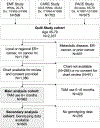CYP2D6-inhibiting medication use and inherited CYP2D6 variation in relation to adverse breast cancer outcomes after tamoxifen therapy
- PMID: 30542984
- PMCID: PMC6353670
- DOI: 10.1007/s10552-018-1117-x
CYP2D6-inhibiting medication use and inherited CYP2D6 variation in relation to adverse breast cancer outcomes after tamoxifen therapy
Abstract
Purpose: Tamoxifen is widely used to reduce the risk of breast cancer (BC) recurrence and extend disease-free survival among women with estrogen-sensitive breast cancers. Tamoxifen efficacy is thought to be attributable to its active metabolite, which is formed through a reaction catalyzed by the P450 enzyme, CYP2D6. Inhibition of tamoxifen metabolism as a result of germline genetic variation and/or use of CYP2D6-inhibiting medications ("inhibitors") is hypothesized to increase the risk of adverse BC outcomes among women taking tamoxifen.
Methods: The present cohort study of 960 women diagnosed with early-stage BC between 1993 and 1999 examined the association between concomitant use of CYP2D6 inhibitors and adjuvant tamoxifen and the risk of adverse BC outcomes (recurrence, second primary BC, BC mortality), both overall and according to CYP2D6 metabolic phenotype.
Results: Six or more months of CYP2D6 inhibitor use concomitant with tamoxifen was not associated with any appreciable increase in risk of recurrence or second primary BC or BC mortality, and there was no clear evidence of variation by CYP2D6 metabolic phenotype.
Conclusions: These results are consistent with the relatively few other large, population-based studies conducted to date that have not observed an increased risk of adverse BC outcomes associated with CYP2D6 inhibition.
Keywords: Breast cancer; CYP2D6; Pharmacogenetics; Survival; Tamoxifen.
Conflict of interest statement
Figures


Similar articles
-
The impact of cytochrome P450 2D6 metabolism in women receiving adjuvant tamoxifen.Breast Cancer Res Treat. 2007 Jan;101(1):113-21. doi: 10.1007/s10549-006-9428-0. Epub 2006 Nov 18. Breast Cancer Res Treat. 2007. PMID: 17115111
-
Potent CYP2D6 Inhibiting drugs do not increase relapse rate in early breast cancer patients treated with adjuvant tamoxifen.Breast Cancer Res Treat. 2011 Jan;125(2):505-10. doi: 10.1007/s10549-010-1008-7. Epub 2010 Jul 1. Breast Cancer Res Treat. 2011. PMID: 20593233
-
Genetic polymorphisms of CYP2D6 increase the risk for recurrence of breast cancer in patients receiving tamoxifen as an adjuvant therapy.Cancer Chemother Pharmacol. 2012 Jul;70(1):75-81. doi: 10.1007/s00280-012-1891-1. Epub 2012 May 24. Cancer Chemother Pharmacol. 2012. PMID: 22623212
-
Cytochrome P-450 2D6 (CYP2D6) Genotype and Breast Cancer Recurrence in Tamoxifen-Treated Patients: Evaluating the Importance of Loss of Heterozygosity.Am J Epidemiol. 2017 Jan 15;185(2):75-85. doi: 10.1093/aje/kww178. Epub 2016 Dec 17. Am J Epidemiol. 2017. PMID: 27988492 Free PMC article. Review.
-
Pharmacogenomics toward personalized tamoxifen therapy for breast cancer.Pharmacogenomics. 2015;16(3):287-96. doi: 10.2217/pgs.14.171. Pharmacogenomics. 2015. PMID: 25712191 Review.
Cited by
-
Pharmacogenomics of breast cancer: highlighting CYP2D6 and tamoxifen.J Cancer Res Clin Oncol. 2020 Jun;146(6):1395-1404. doi: 10.1007/s00432-020-03206-w. Epub 2020 Apr 8. J Cancer Res Clin Oncol. 2020. PMID: 32270286 Free PMC article. Review.
-
Association between genetic polymorphisms in cytochrome P450 enzymes and survivals in women with breast cancer receiving adjuvant endocrine therapy: a systematic review and meta-analysis.Expert Rev Mol Med. 2022 Jan 7;24:e1. doi: 10.1017/erm.2021.28. Expert Rev Mol Med. 2022. PMID: 34991754 Free PMC article.
-
Germline variants in cancer therapy.Cancer Drug Resist. 2019 Mar 19;2(1):18-30. doi: 10.20517/cdr.2019.05. eCollection 2019. Cancer Drug Resist. 2019. PMID: 35582146 Free PMC article. Review.
-
Pharmacogenetics of tamoxifen in breast cancer patients of African descent: Lack of data.Clin Transl Sci. 2024 Mar;17(3):e13761. doi: 10.1111/cts.13761. Clin Transl Sci. 2024. PMID: 38476074 Free PMC article. Review.
-
CYP2D6 Phenotype and Breast Cancer Outcomes: A Bias Analysis and Meta-Analysis.Cancer Epidemiol Biomarkers Prev. 2025 Feb 6;34(2):224-233. doi: 10.1158/1055-9965.EPI-24-0755. Cancer Epidemiol Biomarkers Prev. 2025. PMID: 39540781 Free PMC article.
References
-
- Early Breast Cancer Trialists’ Collaborative Group (EBCTCG). (2005). Effects of chemotherapy and hormonal therapy for early breast cancer on recurrence and 15-year survival: an overview of the randomised trials. Lancet 365(9472):1687–1717. - PubMed
-
- Jin Y, Desta Z, Stearns V, Ward B, Ho H, et al. (2005). CYP2D6 genotype, antidepressant use, and tamoxifen metabolism during adjuvant breast cancer treatment. J Natl Cancer Inst 97:30–9. - PubMed
MeSH terms
Substances
Grants and funding
LinkOut - more resources
Full Text Sources
Medical

